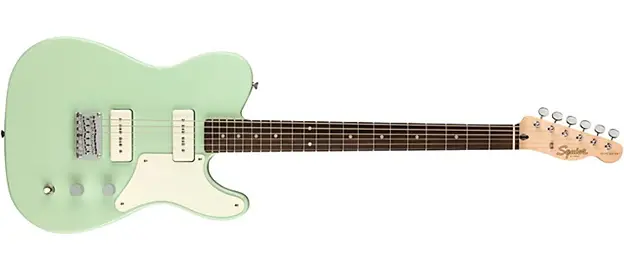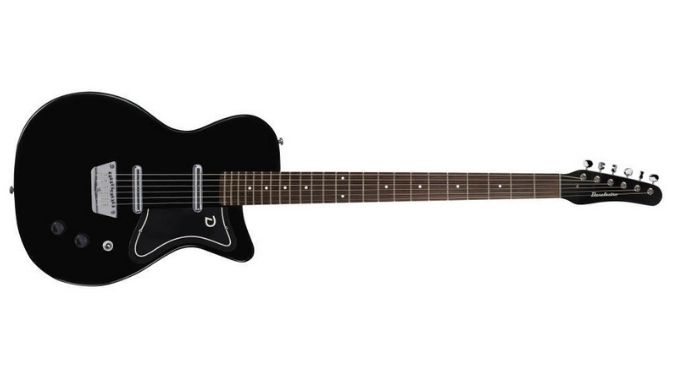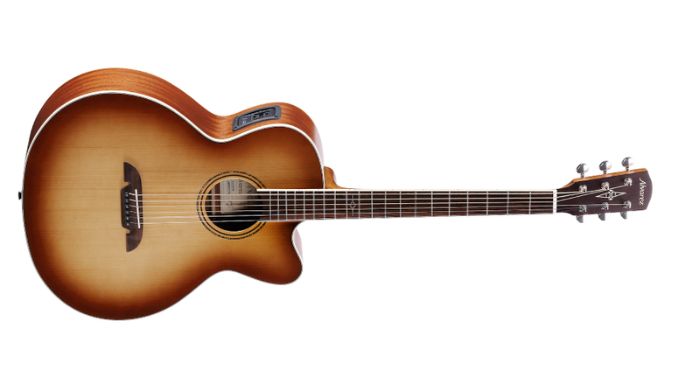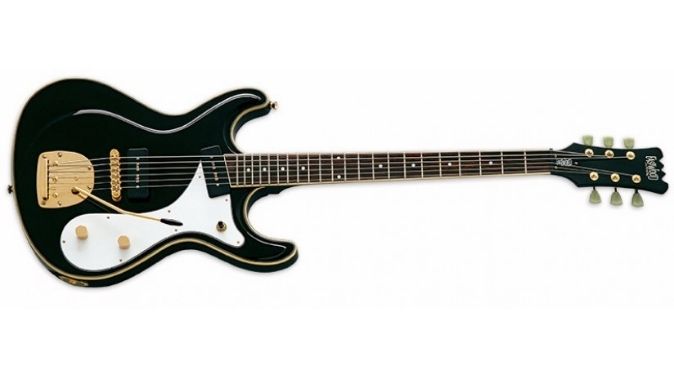If you put the hammer of Thor and a Gibson ES-335 into a blender and then produced the resulting guitar overseas to keep the sticker price reasonable, you would have the Hagstrom Viking Baritone. The folks at Hagstrom boldly assert that the Viking will “shatter all of your baritone stereotypes.” Does the Viking live up to Hagstrom’s claims? Yes and no. Read our review to find out two reasons you might want to buy the Hagstrom Viking Baritone… and one reason you might hesitate.
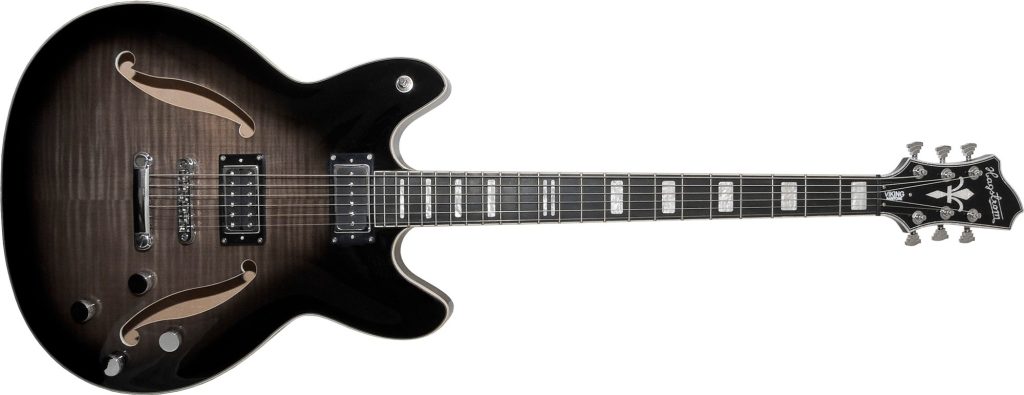
Introducing the Hagstrom Viking Baritone Guitar
The Sweden-based Hagstrom company began making guitars in the late 50s and continued to do so until the company ceased production in 1983. Production resumed in 2004, with the company headquarters remaining in Sweden and manufacturing relocated to China. Today, Hagstrom guitars blend subtle innovative appointments with the vibe of their original designs and/or various takes on Gibson and Fender body concepts. The result of this blending of old and new is a line of guitars that end up feeling distinct and well-designed.
To help get a feel for the Viking, check out this video. Then read on to learn the three things you need to know before you pick up a Hagstrom Viking.
Reasons You Might Want to Buy the Hagstrom Viking Baritone
1. The Hagstrom Viking is different… but not cheesy.
We’ve all seen guitars that end up being different for the sake of being different, with no thought given to how an actual musician would use them (I am picturing a BC Rich Warlock). These “gimmick over substance” guitars end up flooding garage sales and have no chance of becoming tools of the serious guitarist’s trade.
Thankfully, the Hagstrom Viking Baritone stands out without being cheesy. The guitar boasts multiple unique features that make it distinctive in tone and playability, not just looks. For starters, the Viking’s semi-hollow body is unique among production model electric baritones. No other manufacturer is producing a baritone in the Gibson ES-335 style body.
Like a Gibson ES-335, the Viking features two larger hollow wings around a solid center block. Because of this design, you end up with some of the tonal characteristics of a big jazz box guitar (smooth-yet-ample bass, bell-like mid-tones, mellow highs) and the attack and sustain of a solid body guitar. The presence of the center block also means you can increase the distortion and the volume without worrying about feedback
Other unique features include the Viking’s full-sized P-90 neck pickup and its composite fretboard. Both play a prominent role in subsequent sections of this article and, as such, I will wait to unpack their implications.
2. The Hagstrom Viking Packs a ‘Viking-longboat-full’ of Tonal Possibilities!
The clean tones from the Viking Baritone are among the best you will hear from a production model baritone. The folks at Hagstrom have gifted the world with a full-bodied baritone that can produce deep and smooth jazz lines, snappy vintage colors, and arpeggios and fingerpicking tones that will have you closing your eyes and soaking in the music. The Viking’s clean tones are especially exquisite when the neck position P-90 is engaged.
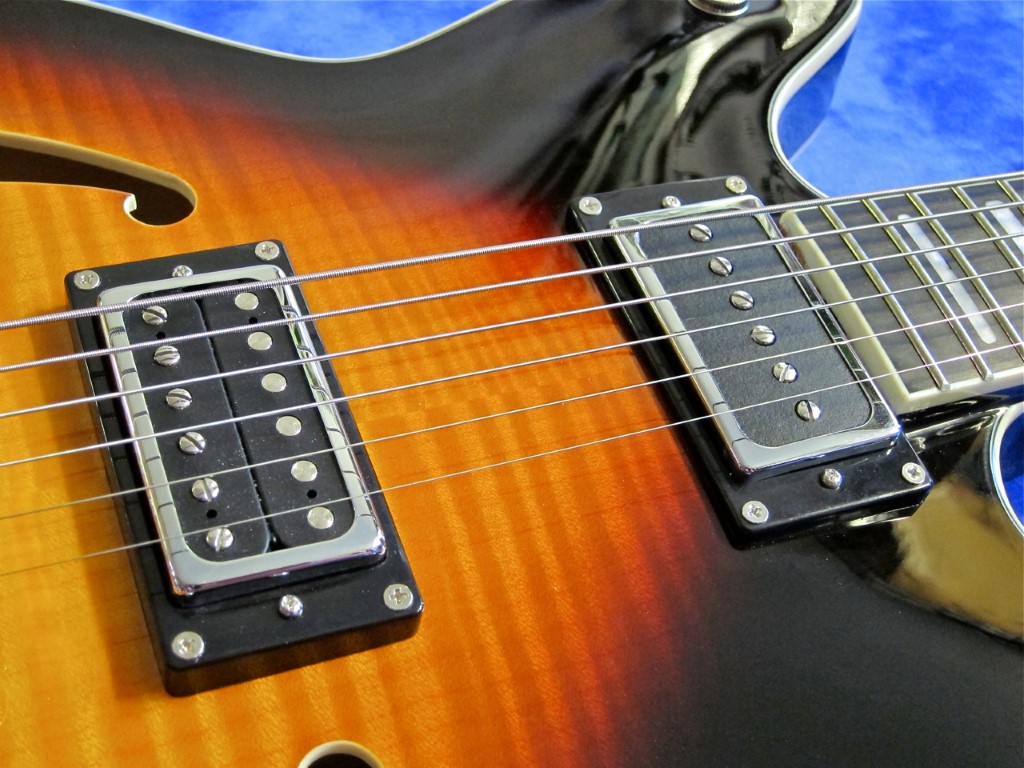
In terms of overall quality, I would put Viking’s clean tones up against that of the Reverend HC Baritone. However, it is worth stating that comparing the tones of the Reverend HC to that of the Hagstrom Viking is a bit like comparing an excellent Chicago deep-dish pizza and an excellent New York thin-crust pizza. Both are great, but personal preference will end up being the determining factor in deciding a favorite.
Surprisingly, the Viking can also deliver a lot of distortion-soaked crunch and still render clear, articulate, and musical tones. This is most likely the result of the Vikings’ combination of pickups (a Hagstrom-designed humbucker at the bridge and a P-90 at the neck) and Hagstrom’s novel choice to build the Viking Baritone mostly out of maple, a tonewood known for sharper attack and greater high-end response.
All tones considered, this Swedish baritone is a versatile machine. Yes, some might prefer the Reverend HC and thrashers and metalheads might gravitate towards the Ibanez RGIB6, but this Viking can hold its own. If you don’t believe me, check out this great demo video coming to us from somewhere inside continental Europe.
Reasons You Might Think Twice Before Buying the Hagstrom Viking Baritone
1. Reports of Quality of Build & Durability Issues
Now, I know that some of you dismissed this baritone once you read that it was manufactured in China. However, a lot of great premium products are made in China: iPhones, iPads, most computers, and nearly all of the air conditioners the southern half of the United States uses to stay cool in the summer come from the land of the rising sun. If we can trust “designed in the US, made in China” for these products, can we trust “designed in Sweden, made in China” when it comes to a guitar? Unfortunately, the answer here seems to be “no” for the Viking Baritone.
The Viking fretboard is made of a proprietary composite material that the folks at Hagstrom call “resonator,” which provides a traditional feel while being stronger than a traditional fretboard. This composite wood appears to have no negative impact on tone. As a side note, it also removes the ethical sourcing concerns associated with some high-end fretboard woods such as Brazilian rosewood or ebony. Personally, if it doesn’t hinder tone or playability, I welcome novel design alternatives to deforestation.
The Hagstrom composite fretboard features a 15-inch radius, placing the Viking firmly in the modern “wide and thin” family of neck styles. Earlier models featured a 12-inch neck radius, resulting in a more strat-like feel.
Sadly, quality of materials concerns show up once we consider the Viking’s frets and electronics. Since this review was originally published, I’ve received several reports of the Viking suffering from the following issues, many of which seem to pop up after some period of regular use:
- Tone pots that break down, crackle, and need replacing.
- Frets that come loose.
- Frets that show wear too quickly.
Now, please note that I am not trying to hold the Viking to the same standard as a premium baritone guitar such as the PRS limited-run baritone. But, the issues mentioned above simply should not happen on any guitar, let alone one priced above the $500 mark.
Conclusion
The Hagstrom Viking Baritone offers scrupulous and versatile tones and a design that is unique among baritone guitars. Should you throw down the cash for this Swedish musical warrior? If the only factor were tone, the answer might depend on the following:
Do you prefer warmer, smoother tones (think ES-335 meets Les Paul Special) over brighter and edgier tones (think Stratocaster or Tele)? If you answered yes, it will be hard to find a better baritone for you than the Viking.
On the other hand, if you lean more toward the Fender side of the tonal force (and can afford an extra $300), consider the Reverend HC Baritone. If metal and shred are your jam, check out the Ibanez RGIB6. Or, If you need an electric baritone for under $500, check out the Eastwood Sidejack.
However, tone is not the only consideration when one purchases a baritone guitar and the Hagstrom Viking’s quality of build issues should be a cause for hesitation.
The folks at Hagstom deserve kudos for offering the world a unique baritone that looks good and sounds great. With some improvements in the quality of its frets and electronics, this could be an amazing guitar. As it stands, the Viking belongs in the buyer-beware category. Still, if you get the chance, take the Viking Baritone for a test drive. Your ears will thank you.
Key Features & Specs
- Current Price: Guitar Center
- Body: Semi-Hollow Contoured Ply Flamed Maple
- Neck: Canadian Hard Maple, set
- Fingerboard: Resinator Fretboard
- Fretboard Radius: 12
- Tuning: 18:1 Die Cast
- Scale Length: 28″
- Pickups: Custom 58’C Bridge, P-90 Neck
- Pickup Selector: 3-Way Toggle Switch
- Bridge: Tune-O-Matic w/ Hagstrom Stop Tail
- Controls: 2 Volume, 2 Tone
- String Setup: 13-62 – .013, .017, .026, .036, .046, .062
- Case sold separately

